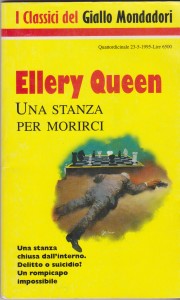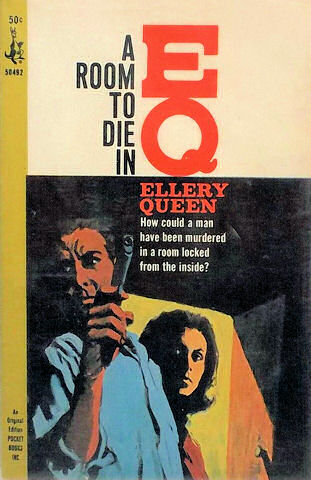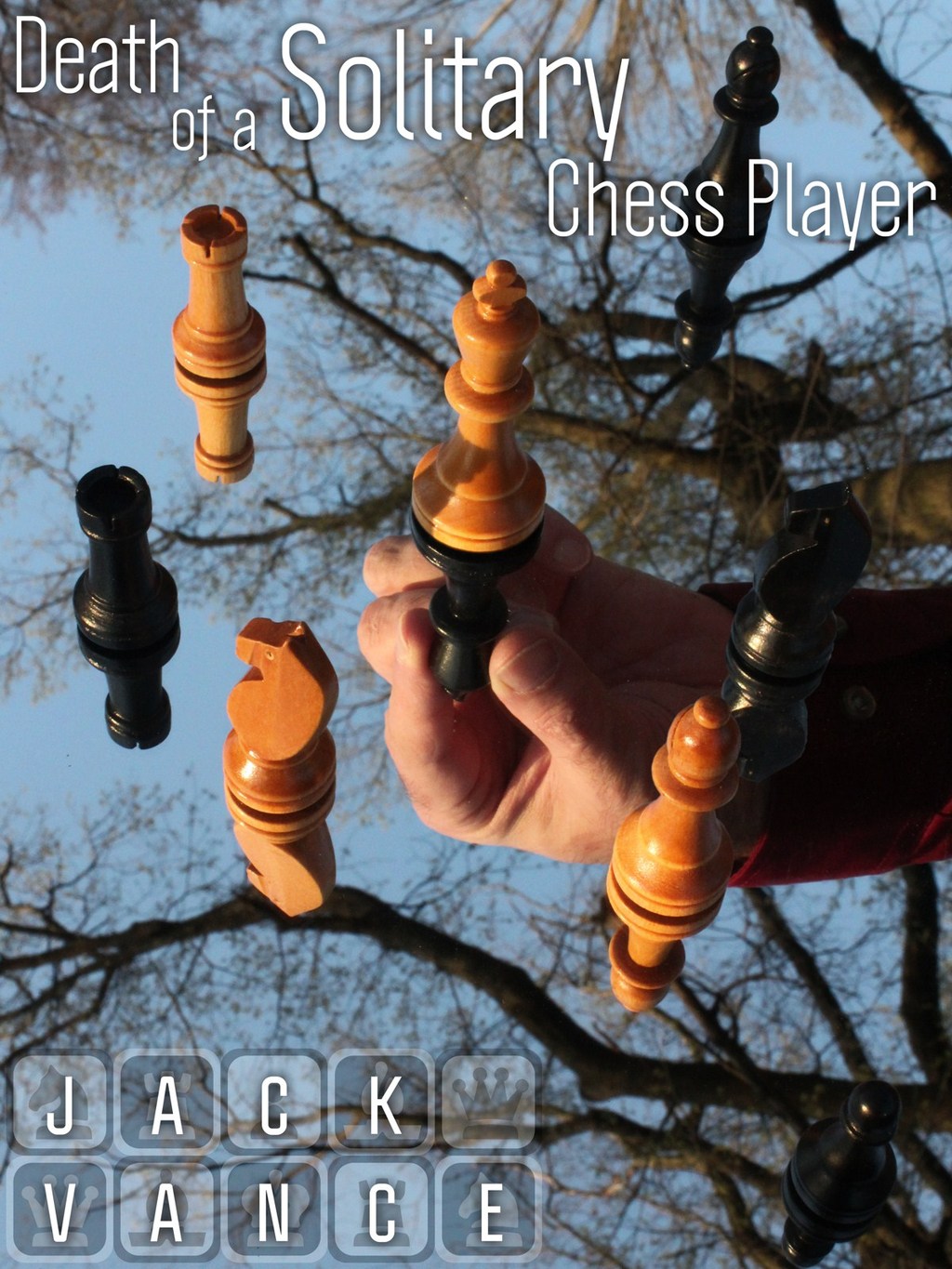As it is well known by now, the two cousins Manny and Danny QUEEN, thought at
one point to stop the series of Ellery Queen. Probably they saw themselves out of the world, with an Ellery
that extricated himself with puzzles that if respected the '' enigma deductive
formal "in the words by Francis Nevins, were not compatible with the
address which had taken the Crime Fiction after the end of World War II: less
brainy puzzles, and more action and violence. The Finishing Stroke, therefore,
would have to be the "swan song" of the series. But, instead, the
novel of 1958, was the last only in intention, because, five years later, in
1963, the two cousins thought to resume cooperation and continue the queenian series
with The
Player on the Other Side . However, something was not right.
In fact, two years before, in essence two years after The Finishing Stroke, was published a novel called Dead Man's Tale. Radically different style, seemed squeak not a little with that idea of detective fiction that Ellery Queen had imposed until to two years before. The beauty is that it was not a solitary incident, but was followed by 26 novels all very different, because – this, the idea revolutionary base - the two cousins (Manfred Lee), entrusted to a series of minor authors, the continuation of their series, creating a kind of parallel track but radically different.
In fact, two years before, in essence two years after The Finishing Stroke, was published a novel called Dead Man's Tale. Radically different style, seemed squeak not a little with that idea of detective fiction that Ellery Queen had imposed until to two years before. The beauty is that it was not a solitary incident, but was followed by 26 novels all very different, because – this, the idea revolutionary base - the two cousins (Manfred Lee), entrusted to a series of minor authors, the continuation of their series, creating a kind of parallel track but radically different.
Essentially those who we
usually call "queenian apocryphal ", a
term that does not do justice to the
experiment, were novels that broke the formal unity of the novels until to that of 1958, but
(it is also true) that they had the” imprimatur” by one of the Queen, Lee, who
supervised the work and often turned a novel, in a good novel.
Among the authors, figured often also known science fiction authors, borrowed gender "mystery", as Edward D. Hoch, Theodore Sturgeon or Jack Vance, as well as authors of rank hardboiled as Hanry Kane.
Three novels of the series were written by Jack Vance, "well-known science fiction writer, who “was one among the few writers that wrote apocryphal to have deliberately adopted queenian situations and topics”: The Four Johns; The Madman Theory; A Room to Die In.
Among the authors, figured often also known science fiction authors, borrowed gender "mystery", as Edward D. Hoch, Theodore Sturgeon or Jack Vance, as well as authors of rank hardboiled as Hanry Kane.
Three novels of the series were written by Jack Vance, "well-known science fiction writer, who “was one among the few writers that wrote apocryphal to have deliberately adopted queenian situations and topics”: The Four Johns; The Madman Theory; A Room to Die In.
Why
did he
write them? In an interview, he
revealed that: "... Because Ellery Queen gave me a flat fee of 3,000 dollars for
each book. Which
was then a
lot of money! I
did have to sign a contract never
to reveal I actually wrote the books. Theoretically
I Never Took His
Name. In a way he took my good proze and did everything to
let it pass as
His Own".
Novel noteworthy, A Room To Die In is a variation of "Locked Room", not very orthodox, but still worth mentioning. The Apocryphal, and this novel confirms this, they were not necessarily works of fiction that had to take other ways than those visited by Queen, that not necessarily have to be alternatives to the Mystery works. What changes is the style of writing less voluptuous than by Queen, dense of meta-meanings and the fact that they are novels that have different detectives, but not Ellery. It 'also true that there are novels, included in the canon of queenian authentic works, that aren’t indeed authentic: The Player on the Other Side (written by Dannay with Theodore Sturgeon) or ... And On The Eighth Day ... (written by Dannay along with Avram Davidson), or The Fourth Side of The Triangle or The House of Brass (same collaboration ).
Novel noteworthy, A Room To Die In is a variation of "Locked Room", not very orthodox, but still worth mentioning. The Apocryphal, and this novel confirms this, they were not necessarily works of fiction that had to take other ways than those visited by Queen, that not necessarily have to be alternatives to the Mystery works. What changes is the style of writing less voluptuous than by Queen, dense of meta-meanings and the fact that they are novels that have different detectives, but not Ellery. It 'also true that there are novels, included in the canon of queenian authentic works, that aren’t indeed authentic: The Player on the Other Side (written by Dannay with Theodore Sturgeon) or ... And On The Eighth Day ... (written by Dannay along with Avram Davidson), or The Fourth Side of The Triangle or The House of Brass (same collaboration ).
Moreover
about queenian Locked Rooms, is not that there are a
lot: The King is Dead, The Door Between,
The Chinese Orange Mystery. But the solution adopted here, is at the limit: it is a work of break.
Why? The locked room, it is quite dissimilar from the construction of a Locked Room tout court, as had been theorized by Carr, Rawson, Boucher and Derek Smith. It provided basically three possible moments (a room in which the crime occurred before, one in which occurred at the same time and finally another where the victim is killed after) and an endless array of tricks to close the door or windows . Here, instead, we resort to a solution that subverts the rule inspirational background, that’s the murderer’s flee from a locked room.
Why? The locked room, it is quite dissimilar from the construction of a Locked Room tout court, as had been theorized by Carr, Rawson, Boucher and Derek Smith. It provided basically three possible moments (a room in which the crime occurred before, one in which occurred at the same time and finally another where the victim is killed after) and an endless array of tricks to close the door or windows . Here, instead, we resort to a solution that subverts the rule inspirational background, that’s the murderer’s flee from a locked room.
Roland Nelson was found
dead in his house, in a hermetically sealed room, with many bolts and latches to think that
he feared for his safety. His death is defined as
suicide by the Inspector Thomas
Tarr when he
shall report the circumstances to his daughter Ann, reached
by a policeman at home.
For the police the case is closed, for the daughter not. She does not stop. She knew too much his father, a man full of life, that would never have killed himself. Yet the fact of the discovery of his corpse is there to remind her that it must be suicide. But she does not believe it.
By whom he was afraid of being killed? Why on his bank account is a shortfall of twenty thousand dollars and then two thousand monthly withdrawals, as if he had paid a blackmailer? And why a blackmail?
For the police the case is closed, for the daughter not. She does not stop. She knew too much his father, a man full of life, that would never have killed himself. Yet the fact of the discovery of his corpse is there to remind her that it must be suicide. But she does not believe it.
By whom he was afraid of being killed? Why on his bank account is a shortfall of twenty thousand dollars and then two thousand monthly withdrawals, as if he had paid a blackmailer? And why a blackmail?
Roland Nelson had had a daughter by partner Elaine Gluck without ever having married, but then he was married with a rich woman, Pearl Maudley. The marriage,for a certain insensitivity by Roland was shipwrecked soon but she did not want a divorce, and so one night, after being by Cypriano, a couple of friends, Pearl had died by accident.
Roland had inherited a fortune. Is it possible that he had had any responsibility in the death of his wife and anyone had discovered it? Tarr also investigates in this sense, but he doesn’t find anything.
The private life of
Roland is screened thoroughly. He was a chess player, which could also become a
better player if he had persevered and had it been less bold. His usual playmate
had been Alexander Cypriano, an excellent player who, once learned the death of
Roland, shows up at the Roland’s daughter inviting her to lunch. Ann understands
there is down something: she thinks that the reason may be a valuable board that
found among the belongings of his father, ebony inlaid with rubies and diamonds,
the memory of a great victory in an international tournament. Cypriano said it was
his and had been given to Roland Nelson after a joke. But then she discovers that
the house of Cypriano is mortgaged and registered holder of the mortgage was Pearl,
from which it had passed to Roland. But this mortgage is not found.
Even ambiguous are two other characters: the landlord of Nelson, the builder Martin Jones, and a cousin of Pearl, Edgar Maudley.
Even ambiguous are two other characters: the landlord of Nelson, the builder Martin Jones, and a cousin of Pearl, Edgar Maudley.
The
first is unpleasant
man, who speaks ill about Roland Nelson, and offends Ann; the
second is a bird of prey, defrauded
about the family treasure from the marriage of Pearl with Roland: a cousin that
he would be heir by Pearl if
Roland had not had a recognized daughter.
Now he is there to
ask her, when not to impose her almost the
return of family assets. Ann
does not intend to take advantage
about the situation but not even to be taken by a fool;
and so she agrees about the division of assets,
especially books of rare editions, contained
in two large bookcases
against the wall covered with wooden panels, which divides the study room from the living room.
For most, the Ann’s mother is not found. Is she the blackmailer? It comes a her letter that obliges to think about her impending arrival. But ... nothing.
Also other things do not add up.
For most, the Ann’s mother is not found. Is she the blackmailer? It comes a her letter that obliges to think about her impending arrival. But ... nothing.
Also other things do not add up.
First of all the
shots: they are heard three during the night at which died Nelson, but only a
bullet has killed him and there is no sign about the other two: either bullets or shells. Then the
question about the mortgage: she finds it
was torn by Roland after he and Alexander are played to chess having as trophy
for the winner, Jehane, wife of Alexander and bedfellow of Nelson. Roland had won, she obviously had refused to
be used as a thing, her husband had offered his precious board to rival, and Roland had torn
the mortgage as to seal the end of his relationship (with his lover: Jehane). And
finally the footprints left on the floor: Ann in her desperate search of truth,
analyzed the impossibility of the situation of his father's death, and passed
to sift all, focuses her action on the two libraries and realizes that on the
ground there are a number footprints circular: there should be six and nine instead
she finds, although the walls are solid.
After two more murders (the
husband of his mother Elaine, Harvey Gluck, strangled instead of Ann, in the
bathroom of Ann; and her mother Elaine, strangled three months before and found
in the trunk of her car, abandoned in a junkyard ), Ann will understand the
motive of the murder and will find the solution, the culprit and will deliver
him to Tarr, hopelessly in love with her.
Beautiful novel, has an ending that recalls somehow the French literature of thirties: the murderer is found at the moment when you understand how was thought the Locked Room, because his criminal action identifies him as the only one that would could achieve it in that context. Beyond this, the novel (its original title was Death of a Solitairy Chess Player ) rows that it is a pleasure.
Ann seeks out, Ann tries, Ann is
in danger, Ann solves. The police action is limited to mostly the confirmation
and elimination of false leads, with its investigation.
Then..it’s interesting the
structure of the plot: about the Locked Room it’s talking at the beginning, at
the discovery of the corpse; then we talk about other things: blackmail, other
characters in the drama. Then returns the speech about the Locked Room, and once you move away from it, and
this stretch and contract the rope goes even further: it is as if the Locked
Room, while not always talking about it, conditioned the course of the novel,
because at the end, everything we talked about, and we thought served to
distract the reader “stretching the broth”, actually it finds in the final. Jack
Vance is linear in his estate, but you
can see a mile away that he was not a writer paid to the Mystery. From what? From
the suicide.
The police, until it’s
proven otherwise, supports the theory of suicide. For the fact that the body
was found in a hermetically sealed chamber, with a wound-blank. The beauty is that
it does not explain everything: strange this
police! If Roland shot himself, the paraffin glove would prove it: but..has
been done the paraffin glove? No. Why? Maybe - thinks the reader – the police was so convinced about the suicide. OK. And the
wound-blank? How was it possible that the murderer could fire at point-blank to
Roland without he did not fit? Without signs
of a struggle had been found, scratches, or worse that the victim had been stunned
or drugged. Nothing. Nothing to explain this. Strange this! Moreover, the medical
examiner, who always enters in the investigation by Ellery (Sam Prouty) with his
characteristic shape, you do not see him here. It’s as if naively Vance would
put axioms without prove them, that
instead belongs at the normal procedure of implantation and resolution of a classic
detective novel. And the gun? A pistol .38
you don’t know if it was property by
victim or not. You don’t know how it can be entered, if it is suicide. That's all
this is not explained in the novel.
In conclusion ...
The solution remains, nice. But then you realize that it's all a bluff. Because the murderer didn’t go out from the locked room, if anything he created it.
In conclusion ...
The solution remains, nice. But then you realize that it's all a bluff. Because the murderer didn’t go out from the locked room, if anything he created it.
Pietro De Palma




I think that thanks for the valuabe information and insights you have so provided here.
ReplyDeleteproduct